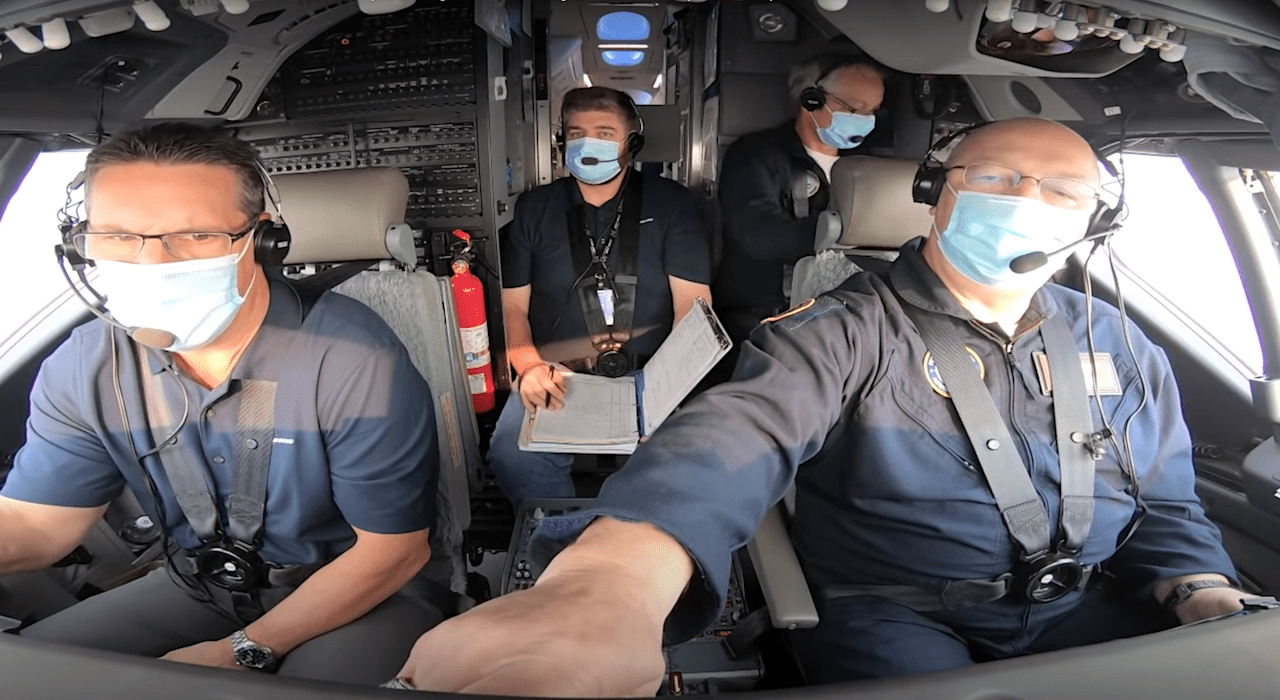
FAA Administrator Steve Dickson completed a test flight of the software and design changes integrated into the 737 MAX on Sept. 30. (FAA)
FAA Administrator Steve Dickson performed two landings and evaluated the Boeing 737 MAX flight control system software and design changes as an international board of aviation experts continue to review training and other aspects of the aircraft before it can be ungrounded.
Dickson said he liked what he saw from the response of the aircraft while flying and that he would share some feedback with Boeing and the FAA team reviewing the changes. The grounding of the MAX is now approaching 18 months after Lion Air Flight 610 and Ethiopian Airlines Flight 302 killed a combined 346 passengers and crew onboard.
“I liked what I saw. It’s been a constructive week. That doesn’t mean that I don’t have some debrief items for the Boeing team and the FAA team,” Dickson said following the test flight.
“I have some, a few items I want to point out, more items of how various things are emphasized, not so much in the procedures, but some of the narrative that describes the procedures and some of the human factor issues on the aircraft and that’s bringing in my number of years of experience in airline operational training and additional things I think could use a little more emphasis perhaps, and that’s where I want to have that dialogue,” he added.

The FAA published B-roll video of their 737 MAX test flight in Seattle this week on YouTube. (FAA)
The FAA Administrator’s test flight comes following his agency’s participation in the Joint Operations Evaluation Board’s (JOEB) review of the pilot training needs for the MAX at London Gatwick Airport. There, he also participated in new simulator training, which included among other tests, evaluation of the use of the Maneuvering Characteristics Augmentation System (MCAS).
In remarks following the flight, Dickson also made it clear that his test flight was separate from the ongoing work of the JOEB, and the separate independent technical advisory committee review of the MAX’s upgrades. He wanted to be able to experience the changes himself inside the actual cockpit as a pilot, he said.
“It responded well. I did two landings, and some air work maneuvers over about a two hour period. I felt prepared that the training prepared me to be very comfortable to fly it, and I actually haven’t flown the 737 in more than 10 years, it’s been 15 years now,” Dickson said. “But we’re not to the point where we’ve completed the process, we’ve got a number of comments on the NPRM, we have to let the JOEB report be completed, we’re going to put that out as well.”
Upon completing the test flight, the FAA published an outline of the remaining tasks that need to be included prior to the MAX returning to service. Before posting a final airworthiness directive enabling changes to every grounded MAX aircraft that needs it, the agency will review and respond to comments made on the Notice of Proposed Rulemaking (NPRM) that they published in September. Next, the JOEB will publish a draft FAA Flight Standardization Board (FSB) report, which will be posted for public comment as well.
A Continued Airworthiness Notification to the International Community (CANIC) and Airworthiness Directive will be published that addresses all of the known issues for grounding prior to the FAA officially residing the grounding order. Finally, the agency will review and approve training programs for U.S.-registered airlines that operate the MAX.
“These actions are applicable only to U.S. air carriers and U.S.-registered aircraft. While our processes will inform other civil aviation authorities, they must take their own actions to return the Boeing 737 MAX to service for their air carriers. The FAA will ensure that our international counterparts have all necessary information to make a timely, safety-focused decision,” the FAA said in a Sept. 30 news update published to its website.
Dickson’s test flight comes following the European Union Aviation Safety Agency’s (EASA) test flight in Canada. The FAA chief said all of the civil aviation authorities working on the review are striving for consensus, while there is still no clear timeline on when the 737 MAX will be ready to return to passenger-carrying service.